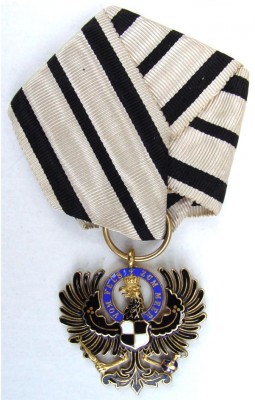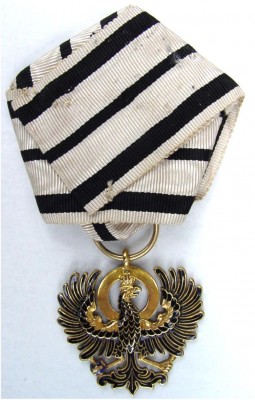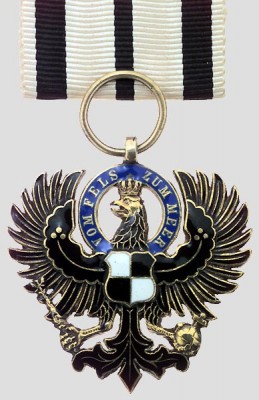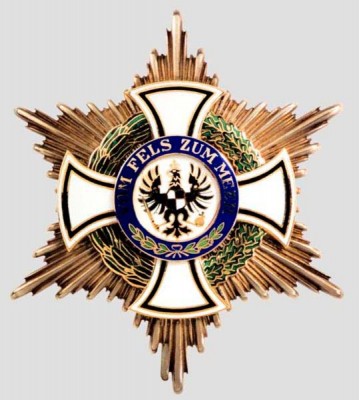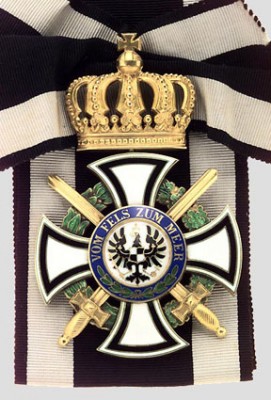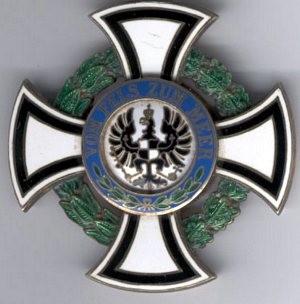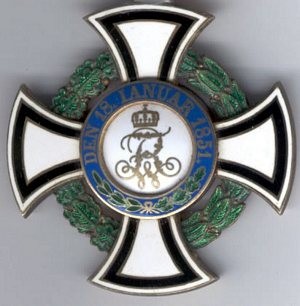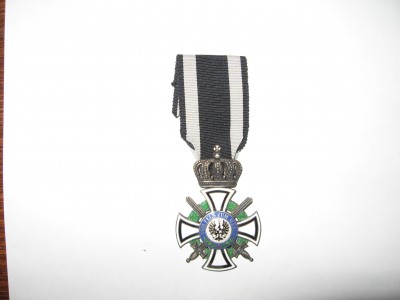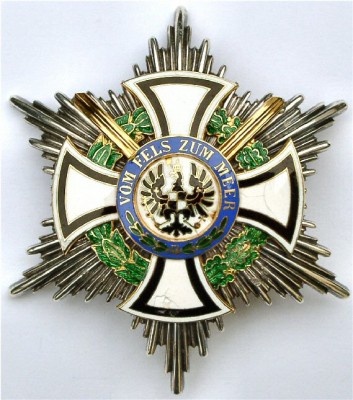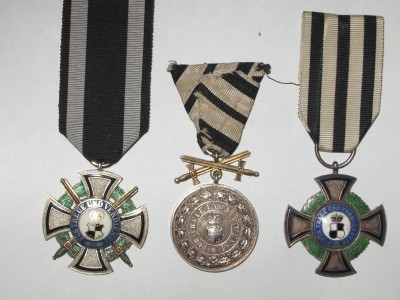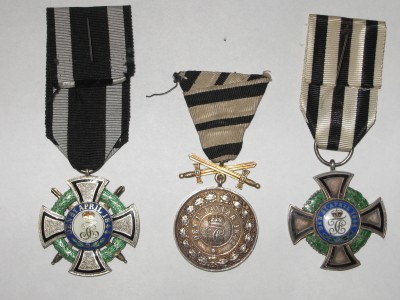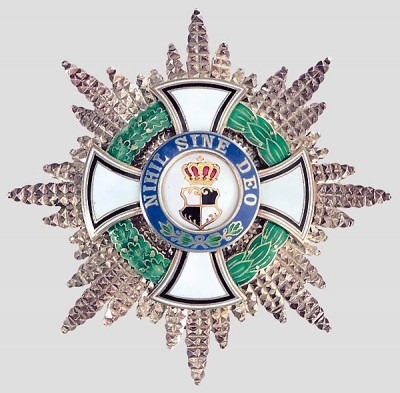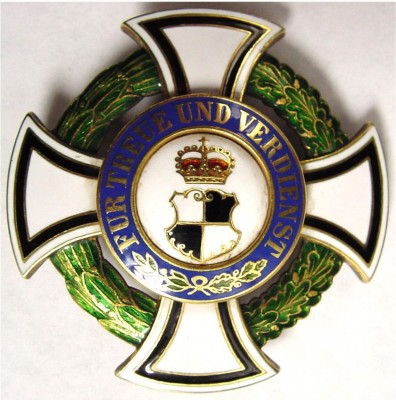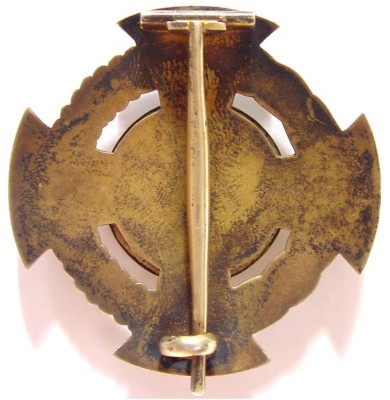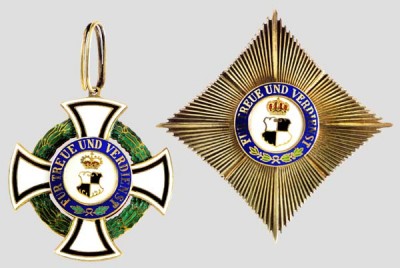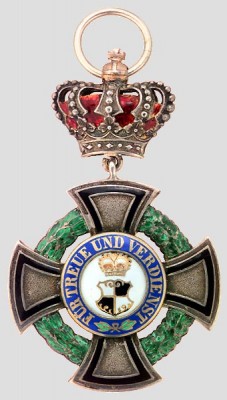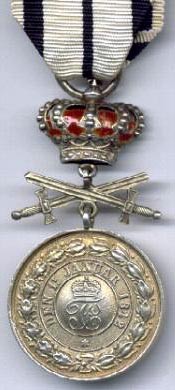| Název: Name: | Královský hohenzollernský domácí řád | House Order of Hohenzollern |
| Název v originále: Original Name: | Königlicher Hausorden von Hohenzollern | |
| Datum vzniku: Date of Establishment: | 05.12.1841 | |
| Datum zániku: Date of Termination: | DD.MM.RRRR | |
| Struktura: Structure: | velkokomtur komtur rytíř nositel | Grand Commander Commander Knight Member |
| Poznámka: Note: | Řádové odznaky můžou být doplněny meči, brilianty, dubovými listy se štítkem 50, 60 nebo vyšším číslem, dubovými listy s Johanitským křížem. | - |
| Zdroje: Sources: | Arnhard Graf Klenau: Grosser Deutscher Ordenskatalog bis 1918, Mnichov 1974 Jörg Nimmergut: Deutschland-Katalog Orden & Ehrenzeichen von 1800 - 1945, Mnichov 1994 | |
Královský hohenzollernský domácí řád
| Název: Name: | Královský hohenzollernský domácí řád - rytíř s meči | Knight's Cross with Swords of the Royal House Order of Hohenzollern |
| Název v originále: Original Name: | Ritterkreuz des Königlichen Hausorden von Hohenzollern mit Schwerten | |
| Datum vzniku: Date of Establishment: | 27.02.1964 | |
| Datum zániku: Date of Termination: | DD.MM.1918 | |
| Komponenty: Components: | - | - |
| Klenot: Badge: | - | - |
| Klenot foto avers: Badge Photo Obverse: | | |
| Klenot foto revers: Badge Photo Reverse: | - | |
| Hvězda: Star: | - | - |
| Hvězda foto avers: Star Photo Obverse: | - | |
| Hvězda foto revers: Star Photo Reverse: | - | |
| Stužka: Ribbon Bar: | - | - |
| Fotografie: Photograph: | | |
| Poznámka: Note: | - | - |
| Zdroje: Sources: | www.ehrenzeichen-orden.de ru.wikipedia.org | |
This order was founded on 23 August 1851 by King Friedrich Wilhelm IV, after the union of the two principalities of Hohenzollern-Hechingen and Hohenzollern-Sigmaring as a continuation of the Princely Order of Hohenzollern, which was founded in 1841.The Order's motto : FOM FELS ZUM MEER ( From the Rock to the Sea) is an old Swabian motto and expressed the desire to extend the dominion to Lake Constance, which was called the sea. The town on the shore of the lake is even called Meersbug. The order became the third Prussian order and was often awarded between 1848 and 1849 to Prussian citizens who remained loyal and faithful to the royal house and the monarch. In recognition of the work of teachers and priests, this order was established in the form of an eagle (see picture) and was awarded in this form for merit in the field of science and culture. On the other hand, military merit and bravery meant to decorate the order with swords,which are inserted between the arms of the cross, or in the elevation of the jewel under the ribbon, which is white with three black stripes. The cross of the Order is of a paw-shaped design, white enamelled with a black border. In the centre of the cross is a black eagle in a white field, holding a sceptre and an imperial apple in its talons and the Hohenzollern arms on its breast. In the blue intercircle is a golden family motto and two laurel sprigs at the bottom. On the reverse of the cross in the medallion, which is white, is the crowned gold monogram F.W.R.(Friedrich Wilhelm IV.Rex) and in the blue intercircle is the date of the reorganization of the order DEN 18.JANUARY 1851.
The group of Eagles, which was intended mainly for teachers and clergy, is decorated with a golden black enamel eagle with outstretched wings, bearing the Hohenzollern arms on its chest and a white ribbon with a motto around its head(see picture)
Both categories are equally divided into four grades.
Grand Komtur with a star ( or without a star)
Commander with or without star, here the star is smaller
Knight/ worn on the breast, silver cross
Owner or bearer of a silver cross, unenamelled
The star of the Grand Commander is eight-pointed silver with a cross of the Order
The star of the Commander is the same, but only six-pointed
Notes:
Dr.Klietmann gives in his work Pour le Mérité und Rapferkeitsmedaili the following numbers of awards in the years of the Great War 1914-18 and the division of the Order:
Star for the Grand Commandery 3
Star for Grand Commander with swords 5
Cross for Grand Commander with swords 1
Cross for Commander with Star 7
Cross for Commander with swords 34
Cross for Knight with Swords 8291
With the number of soldiers who could have received this order, the number of copies of the order awarded is small. These Crosses for Knights with Swords are rarely found in our collections as they were also awarded to officers of the Austro-Hungarian Army.
Sources:
František Lobkowicz: Encyclopedia of Orders and Decorations
Arnhard Graf Klenau: Orden in Deutschland und Osterreiuch
Dr. Klietmann:Pour lé Merité und Tapferkeitsmedaille
Own archive
Knight's Cross of the Royal House of Hohenzollern with swords
As the Order could also be awarded for civilian merit, a version of the Knight's Cross with Swords, awarded exclusively for military merit, was created on 27 February 1864.
In this version, the cross was usually bestowed or awarded to officers for acts of valour in combat. Exceptionally, it could also be awarded to a non-officer.
It occupied a prominent place among Prussian decorations during World War I. It filled the gap between Iron Cross First Class and Pour le Mérite. It was therefore usually awarded if the recipient had previously been awarded the Iron Cross First Class, but could rarely be awarded earlier for special merit.
For fighters, it was usually awarded between the 12th and 15th victories, although this principle did not always apply, of course.
During World War I, 8,291 were awarded.
Although officially it is stated that the order as such ceased to exist in 1918 with the fall of the German Empire, William II, as Grand Commander of the order, bestowed the order during his exile in Holland until his death in 1941 (it is not known whether this was also a military decoration).
Description
A gilded footed cross with rounded arms. The cross is white enamelled with a black inner border. The centre is a round medallion. Between the arms of the cross is a green enamel wreath (the right half of laurel leaves, the left of oak leaves). Two crossed gilded swords are woven into the wreath, passing through the centre of the medallion. The upper arm is surmounted by a gilded Prussian royal crown. On its back side there is a wide transverse loop for a ribbon.
Dimensions of the decoration: 55 × 37 mm.
Weight: 24,5 g.
Medallion obverse:
In the centre of the medallion is a black Prussian eagle with the Hohenzollern coat of arms (black and silver quartered shield) on the chest on a white ground. The Hohenzollern family motto 'Vom Fels zum Meer' (From the Rock to the Sea) in golden script on a blue ground winds around the centre. In the lower part of the medallion two laurel branches tied together.
Reverse of the medallion
In the centre of the medallion decorated with the monogram F W R (Friedrich Wilhelm Rex / Frederick William the King). Above it a royal crown. In the description the date of the Order's foundation DEN - 18 - JANUARY - 1851, again in gold lettering on a blue ground. In the lower part of the medallion again two tied laurel branches.
Ribbon:
Black, 30 mm wide. Two millimetres from the edges two white stripes 5 mm wide.
Strands:
www.ehrenzeichen-orden.de
de.wikipedia.org
It is a historical territory in the south of Germany, originally the county of Zollern.Since the 13th century it has been held by the Swabian branch of the Hohenzollerns.After the revolutionary years 1848-1849 the principality became part of Prussia.Today it is part of the state of Baden-Wurtenberg.
The order was founded in 1841 jointly by two princes, Friedrich Wilhelm Hohenzollern-Hechingen (1838-1869) and Carl Hohenzollern-Sigmaringen (1848-1849). It was intended to honour the merits of the princely house. After the merger of the Hohenzollern Principality with Prussia, it was taken over by the Prussian Hohenzollerns in 1841 and incorporated into the royal orders.
The order is divided into 4 classes:
Cross of Honour, 1st class, pinned on the chest.
Honorary Commander of 1891, worn around the neck.
Cross of Honour 2nd Class, gold cross
Cross of Honour 3rd class, the cross is silver and unenamelled.
The Order includes the Gold and Silver medals.
However, all 4 classes can upgrade to swords and possibly a crown. The military upgrade is also that the order can be worn on the famous Iron Cross ribbon, but not if the decoration is awarded with swords.Both medals can be awarded one with swords and the other with a crown, or with swords and a crown,
The actual decoration of the order is a golden footed cross with curved arms at the end.The cross is white enamelled again with a black border.A green wreath is inserted between the arms.In the round central plate on the front side is the family coat of arms on a princely cloak, surmounted by a crown.Around it is the inscription:FUR TREUE UND VERDIENST(For Loyalty and Merit). The initials of the founders of the FC (Friedrich-Carl) are on the rear central plate.
Literature:
František Lobkovicz: Encyclopedia of Order and Honours, Prague,Libri
Jorg Nimmergut:Deutsche Orden
Diskuse
This post has not been translated to English yet. Please use the TRANSLATE button above to see machine translation of this post.
viz např. www.ehrenzeichen-orden.de
Citace - Advice :
I do not consider myself an expert on the distinctions, but by 1841 it was not according to my sources, founded the royal order of Hohenzollern, but the prince. Royal originated up to the year 1851, both orders continue to exist in parallel. For example, although the knight's cross looked very similar, the medallion was different.
see, e.g., www.ehrenzeichen-orden.de
The order was founded by two knižaty 5.12.1841. After the inclusion of the two principalities into a Prussian kingdom was the order of 23.8.1851 taken into the system of the prussian orders of magnitude. Awarded to this day. Over time there have been many re-organisations, could lead to changes in the design. This situation is commonly occurred not only in the old German states. Eg. the majority of Bulgarian orders was founded in the principality, continued in the empire and in the republic. Often varied such as a central medallion. Or In the Independent state of the Congo arose timetables of African stars, Crown, Lion and Leopold II. After the annexation of that state to the kingdom of Belgium were integrated into the systems of belgian orders. FOR Ř. Leopold II. was changed to the central medallion, the other orders remained unchanged.
This post has not been translated to English yet. Please use the TRANSLATE button above to see machine translation of this post.
Ok, šlo mi jen o to, že tyhle dva řády jinde mají dvě různá témata, u nás jsou pospolu. Pokud je to správně dle našich odborníků, pak je všechno v nejlepším pořádku.
Tady sis ovšem ihned sám naběhl
This post has not been translated to English yet. Please use the TRANSLATE button above to see machine translation of this post.
Tento řád patří do kategorie tzv. dynastických řádů. Potomci(resp. hlavy jejich rodů) vládnoucích rodů udělují (často za úplatu) řady jejich starých řádů doposud bez ohledu na to, že jejich státy už dávno neexistují. A to se týče nejen Hohenzollernů, ale i ostatních staroněmeckých států, ale i mnoha států z celého světa. Např. náš poslanec Karel Schwarzenberg je nositelem rakouského Řádu zlatého rouna i když se narodil v době kdy císařství již neexistovalo.
Já jsem kdysi psal do královské kanceláře jugoslávského krále a císařské kanceláře etiopského císaře žádost o sdělení, které řády udělují, jak vypadají, kolik jich udělili, kdo je vyrábí atd., ale vůbec mi neodpověděli. Přitom "etiopský císař" povyšuje i do šlechtického stavu a na jeho webu je jednoznačně uvedeno, že je to otázka peněz.
K tvému dotazu. Dotyční tyto řády udělují jako vždy, tzn. komu chtějí, tedy i např. členům Bundeswehru nebo tobě. Otázka zda takto vyznamenaní je mohou nosit je otázkou právní úpravy té které země. Obecně se domnívám, že soukromé osoby mohou nosit vyznamenání, která chtějí a kdy chtějí. Ale např. vojáci by je ve většině zemí nemohli nosit. Výjimkou by mohli být někde generálové, u kterých se často ústrojová nekázeň toleruje. U nás za socialismu existoval zákon říkající, že československý občan musí před udělením (výjimečně dodatečně) zahraničního vyznamenání požádat prezidenta republiky o souhlas.
Jinak nějaký řád či medaili si můžeš založit a udělovat i ty. A mělo by to stejný právní status jako ty výše zmiňované řády.
Join us
We believe that there are people with different interests and experiences who could contribute their knowledge and ideas. If you love military history and have experience in historical research, writing articles, editing text, moderating, creating images, graphics or videos, or simply have a desire to contribute to our unique system, you can join us and help us create content that will be interesting and beneficial to other readers.
Find out more